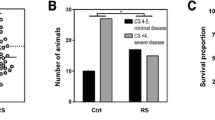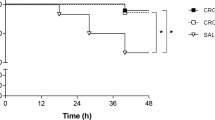Abstract
Rifampin, a protein synthesis inhibitor, reduced mortality in a mouse model of meningitis compared to bacteriolytic cephalosporin standard therapy. To assess whether moxifloxacin (known to cause a less rapid bacteriolysis than cephalosporins) can similarly reduce mortality, mice infected with Streptococcus pneumoniae by deep intracerebral injection were treated subcutaneously with either 200 mg/kg of moxifloxacin or ceftriaxone every 8 hours for 5 days (n=49 each). They were then observed for an additional 8 days. Overall mortalities were 35 and 29 in moxifloxacin- and ceftriaxone-treated mice, respectively (p=0.29). Kaplan-Meier survival analysis also revealed no statistically significant differences (p=0.32). Moxifloxacin failed to reduce mortality compared to cephalosporin standard therapy.
Similar content being viewed by others
References
Hirst RA, Sikand KS, Rutman A, Mitchell TJ, Andrew PW, O’Callaghan C. Relative roles of pneumolysin and hydrogen peroxide from Streptococcus pneumoniae in inhibition of ependymal ciliary beat frequency. Infect Immun 2000;68:1557–1562.
Zysk G, Schneider-Wald BK, Hwang, JH, et al. Pneumolysin is the main inducer of cytotoxicity to brain microvascular endothelia cells caused by Streptococcus pneumoniae. Infect Immun 2001;69:845–852.
Braun JS, Sublett JE, Freyer D, et al. Pneumococcal pneumolysin and H2O2 mediate brain cell apoptosis during meningitis. J Clin Invest 2002;109:19–27.
Stringaris AK, Geisenhainer J, Bergmann F, et al. Neurotoxicity of pneumolysin, a major pneumococcal virulence factor, involves calcium influx and depends on activation of p38 mitogen-activated protein kinase. Neurobiol Dis 2002;11:355–368.
Kim YS, Täuber MG. Neurotoxicity of glia activated by Grampositive bacterial products depends on nitric oxide production. Infect Immun 996;64:3148–3153.
Schmidt H, Tlustochowska A, Stuertz K, et al. Organotypic hippocampal cultures. A model of brain tissue damage in Streptococcus pneumoniae meningitis. J Neuroimmunol 2001;113:30–39.
Iliev AI, Stringaris AK, Nau R, Neumann H. Neuronal injury mediated via stimulation of microglia toll-like receptor-9 (TLR9), FASEB J 2004;18:412–414.
Nau R, Zysk G, Schmidt H, et al. Trovafloxacin delays the antibiotic-induced inflammatory response in experimental pneumococcal meningitis. J Antimicrob Chemother 1997;39:781–788.
Stuertz K, Schmidt H, Trostdorf F, Eiffert H, Mäder M, Nau R. Lower lipoteichoic and teichoic acid CSF concentrations during treatment of pneumococcal meningitis with non-bacteriolytic antibiotics than with ceftriaxone. Scand J Infect Dis 1999;31:367–370.
Azeh I, Gerber J, Wellmer A, et al. The protein synthesis inhibiting clindamycin improves outcome in a mouse model of Staphylococcus aureus sepsis compared to the cell wall active ceftriaxone. Crit Care Med 2002;30:1560–1564.
Stuertz K, Schmidt H, Eiffert H, Schwartz P, Mäder M, Nau R. Differential release of lipoteichoic and teichoic acids from Streptococcus pneumoniae as a result of exposure to β-lactam antibiotics, rifamycins, trovafloxacin, and quinupristin-dalfopristin. Antimicrob Agents Chemother 1998;42:277–281.
Van Langevelde P, Van Dissel JT, Ravensberger E, Appelmelk BJ, Schrijver IA, Groeneveld PHP. Antibiotic-induced release of lipoteichoic acid and peptidogly can from Staphylococcusaureus: quantitative measurements and biological reactivities. Antimicrob Agents Chemother 1988;42:3073–3078.
Böttcher T, Gerber J, Wellmer A, et al. Rifampin reduces production of reactive oxygen species of CSF phagocytes and hippocampal neuronal apoptosis in experimental Streptococcus pneumoniae meningitis. J Infect Dis 2000;181:2095–2098.
Nau R, Wellmer A, Soto A, et al. Rifampin reduces early mortality in experimental Streptococcus pneumoniae meningitis. J Infect Dis 1999;179:1557–1560.
Nau R, Schmidt T, Kaye K, Froula JL, Täuber MG. Quinolone antibiotics in therapy of experimental pneumococcal meningitis in rabbits. Antimicrob Agents Chemother 1995;39:593–597.
Schmidt H, Dalhoff A, Stuertz K, et al. Moxifloxacin in the therapy of experimental pneumococcal meningitis. Antimicrob Agents Chemother 1998;41:1397–1401.
Ostergaard C, Klitmoller Sorensen T, Dahl Knudsen J, Frimodt-Moller N. Evaluation of moxifloxacin, a new 8-methoxyquinolone, for treatment of meningitis caused by a penicillin-resistant pneumococcus in rabbits. Antimicrob Agents Chemother 1998;42:1706–1712.
Rodriguez-Cerrato V, McCoig CC, Michelow IC, et al. Pharmacodynamics and bactericidal activity of moxifloxacin in experimental Escherichia coli meningitis. Antimicrob Agents Chemother 2001;45:3092–3097.
Mason DJ, Power EG, Talsania H, Phillips I, Gant VA. Antibacterial action of ciprofloxacin. Antimicrob Agents Chemother 1995;39:2752–2758.
Gerber J, Raivich G, Wellmer A, et al. A mouse model of Streptococcus pneumoniae meningitis mimicking several features of human disease. Acta Neropathol 2001;101:499–508.
Wellmer A, Noeske C, Gerber J, Munzel U, Nau R. Spatial memory and learning deficits after experimental pneumococcal meningitis in mice. Neurosci Lett 2000;296:137–140.
Frimodt-Moller N, Bentzon MW, Thomsen VF. Experimental infection with Streptococcus pneumoniae in mice: correlation of in vitro activity and pharmacokinetic parameters with in vivo effect for 14 cephalosporins. J Infect Dis 1986;154:511–517.
Britt RH, Enzmann DR, Placone RC, Obana WG, Yeager AS. Experimental anaerobic brain abscess. Computerized tomographic and neuropathological correlations. J Neurosurg 1984;60:1148–1159.
Craig WA, Ebert SC. Killing and regrowth of bacteria in vitro: a review. Scand J Infect Dis 1990;74(Suppl):63–70.
Woodcock JM, Andrews JM, Boswell FJ, Brenwald NP, Wise R. In vitro activity of BAY 12-8039, a new fluoroquinolone. Antimicrob Agents Chemother 1997;41:101–106.
Stass H, Kubitza D. Pharmacokinetics and elimination of moxifloxacin after oral and intravenous administration in man. J Antimicrob Chemother 1999;43 (Suppl B):83–90.
Author information
Authors and Affiliations
Corresponding author
Rights and permissions
About this article
Cite this article
Djukic, M., Böttcher, T., Wellmer, A. et al. Moxifloxacin in experimental Streptococcus pneumoniae cerebritis and meningitis. Neurocrit Care 2, 325–329 (2005). https://doi.org/10.1385/NCC:2:3:325
Issue Date:
DOI: https://doi.org/10.1385/NCC:2:3:325




